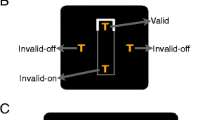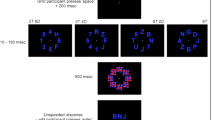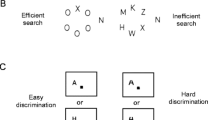Summary
Within contemporary visual-information-processing psychology, two classes of selective-attention theories can be distinguished: position-not-special theories and position-special theories. The position-not-special theories postulate that attentional selection by colour, by form, and by position are equivalent selective operations. The position-special theories assume that selection by position is more basic or direct than selection by colour or by form. Examples of both types of theory are briefly described, and irrelevant and relevant evidence is critically discussed. It is concluded that the relevant evidence is directly compatible with the position-special views and that the position-not-special theories require additional extraneous assumptions. The position-special model presented in Van der Heijden (1992) is elaborated in further detail. It is shown that this model is compatible with two important and often substantiated assumptions of the position-not-special theories: the assumption that pre-attentive analysers organize the visual scene in objects against a background, and the assumption that visual-selective attention can be directed at objects isolated in this way. This position-special theory is a parsimonious theory because it can identify the mentalistic conceptselective attention with the materialistic conceptspatial position.
Similar content being viewed by others
References
Allport, D. A. (1987). Selection for action: Some behavioral and neurophysiological considerations of attention and action. In H. Heuer & A. F. Sanders (Eds.),Perspectives on perception and action. Hillsdale, NJ: Erlbaum.
Allport, D. A. (1989). Visual attention. In M. I. Posner (Ed.),Foundations of cognitive science. Cambridge, MA: MIT Press.
Bongartz, W., & Scheerer, E. (1976). Two visual stores and two processing operations in tachistoscopic partial report.Quarterly Journal ofExperimental Psychology, 28, 203–219.
Broadbent, D. E. (1958).Perception and communication. London: Pergamon Press.
Broadbent, D. E. (1971).Decision and stress. London: Academic Press.
Broadbent, D. E. (1982). Task combination and selective intake of information.Acta Psychologica, 50, 253–290.
Broadbent, D. E., & Broadbent, M. H. P. (1986). Encoding speed of visual features and the occurrence of illusory conjunctions.Perception, 15, 515–524.
Broadbent, D. E., & Broadbent, M. H. P. (1987). From detection to identification: Response to multiple targets in rapid serial visual presentation.Perception & Psychophysics, 42, 105–113.
Bundesen, C. (1990). A theory of visual attention.Psychological Review, 97, 523–547.
Bundesen, C. (1991). Visual selection of features and objects: Is location special? A reinterpretation of Nissen's (1985) findings.Perception & Psychophysics, 50, 87–89.
Bundesen, C., Pedersen, L. F., & Larsen, A. (1984). Measuring efficiency of selection from briefly exposed visual displays: A model for partial report.Journal of Experimental Psychology: Human Perception and Performance, 10, 329–339.
Bundesen, C., Shibuya, H., & Larsen, A. (1985). Visual selection from multielement displays: A model for partial report. In M. I. Posner & O. S. M. Marin (Eds.),Attention and performance XI. Hillsdale, NJ: Erlbaum.
Butler, B. E., Mewhort, D. J. K., & Tramer, S. C. (1987). Location errors in tachistoscopic recognition: Guesses, probe errors, or spatial confusions?Canadian Journal ofPsychology, 41, 339–350.
Cave, K. R., & Wolfe, J. M. (1990). Modeling the role of parallel processing in visual search.Cognitive Psychology, 22, 225–271.
Clark, S. E. (1969). Retrieval of color information from preperceptual memory.Journal of Experimental Psychology, 82, 263–266.
DeYoe, E. A., & Van Essen, D. C. (1988). Concurrent processing streams in monkey visual cortex.Trends in Neuro Sciences, 11, 219–226.
Driver, J., & Baylis, G. C. (1989). Movement and visual attention: The spotlight metaphor breaks down.Journal of Experimental Psychology: Human Perception and Performance, 15, 448–456.
Driver, J., & Halligan, P. W. (1991). Can visual neglect operate in object-centred co-ordinates? An affirmitive single-case study.Cognitive Neuropsychology, 8, 475–496.
Duncan, J. (1980). The demonstration of capacity limitation.Cognitive Psychology, 12, 75–96.
Duncan, J. (1981). Directing attention in the visual field.Perception & Psychophysics, 30, 90–93.
Duncan, J. (1984). Selective attention and the organization of visual information.Journal of Experimental Psychology: General, 113, 501–517.
Duncan, J., & Humphreys, G. W. (1989). Visual search and stimulus similarity.Psychological Review, 96, 433–458.
Eimer, M., Nattkemper, D., Schrbger, E., & Prinz, W. (in press). Unwillkürliche Aufmerksamkeit. In O. Neumann & A. F. Sanders (Eds.), Aufmerksamkeit. Göttingen, Hogrefe.
Enns, J. T. (1990). Three-dimensional features that pop out in visual search. In D. Brogan (Ed.),Visual search. London: Taylor & Francis.
Enns, J. T., & Rensink, R. A. (1991). Preattentive recovery of three-dimensional orientation from line drawings.Psychological Review, 98, 335–351.
Eriksen, C. W. (1990). Attentional search of the visual field. In D. Brogan (Ed.),Visual search. London: Taylor & Francis.
Eriksen, C. W., & Hoffman, J. E. (1973). The extent of processing of noise elements during selective encoding from visual displays.Perception & Psychophysics, 14, 155–160.
Eriksen, C. W., & Hoffman, J. E. (1974). Selective attention: Noise suppression or signal enhancement?Bulletin of the Psychonomic Society, 4, 587–589.
Eriksen, C. W., & Rohrbaugh, J. W. (1970). Some factors determining efficiency of selective attention.American Journal of Psychology, 83, 330–343.
Eriksen, C. W., & St James, J. D. (1986). Visual attention within and around the field of focal attention: A zoomlens model.Perception & Psychophysics, 40, 225–240.
Eriksen, C. W., & Yeh, Y. Y. (1985). Allocation of attention in the visual field.Journal of Experimental Psychology: Human Perception and Performance, 5, 583–597.
Felleman, D. J., & Van Essen, D. C. (1991). Distributed hierarchical processing in the primate cerebral cortex.Cerebral Cortex, 1, 1–47.
Francolini, C. N., & Egeth, H. E. (1980). On the non-automaticity of “automatic” activation: Evidence of selective seeing.Perception & Psychophysics, 27, 331–342.
Fryklund, I. (1975). Effects of cued-set spatial arrangement and targetbackground similarity in the partial-report paradigm.Perception & Psychophysics, 17, 375–386.
Garner, W. R. (1987). Location and color as cuing dimensions in contingent classification.Perception & Psychophysics, 41, 202–210.
Gathercole, S. E., & Broadbent, D. E. (1984). Combining attributes in specified and categorized target search: Further evidence for strategy differences.Memory & Cognition, 12, 329–337.
Hagenzieker, M. P., Van der Heijden, A. H. C., & Hagenaar, R. (1990). Time courses in visual information processing: Some empirical evidence for inhibition.Psychological Research, 52, 13–21.
Hardin, C. L. (1988).Color for philosophers. Indianapolis: Hacket.
Harms, L., & Bundesen, C. (1983). Color segregation and selective attention in a nonsearch task.Perception & Psychophysics, 33, 11–19.
Humphreys, G. W. (1981). Flexibility of attention between stimulus dimensions.Perception & Psychophysics, 30, 291–302.
James, W. (1890/1950).The principles of psychology (Vol. 1). Authorized edition, New York: Dover Publications, Inc.
Jonides, J. (1983). Further toward a model of the mind's eye's movements.Bulletin of the Psychonomic Society, 21, 247–250.
Jonides, J., & Yantis, S. (1988). Uniqueness of abrupt visual onset in capturing attention.Perception & Psychophysics, 43, 346–354.
Kahneman, D. (1973).Attention and effort. Englewood Cliffs, NJ: Prentice-Hall.
Kahneman, D., & Chajczyk, D. (1983). Tests of the automaticity of reading: Dilution of Stroop effects by color-irrelevant stimuli.Journal of Experimental Psychology: Human Perception and Performance, 9, 497–509.
Kahneman, D., & Henik, A. (1977). Effects of visual grouping on immediate recall and selective attention. In S. Dornic (Ed.),Attention and performance VII. Hillsdale, NJ: Erlbaum.
Kahneman, D., & Henik, A. (1981). Perceptual organization and attention. In M. Kubovy & J. R. Pomerantz (Eds.).Perceptual organization. Hillsdale, NJ: Erlbaum.
Kahneman, D., & Treisman, A. (1984). Changing views of attention and automaticity. In R. Parasuraman and P. R. Davies (Eds.).Varieties of attention. New York: Academic Press.
Kanwisher, N., & Driver, J. (1992). Objects, attributes, and visual attention: Which, what, and where.Current Directions in Psychological Science, 1, 26–31.
Keele, S. W., Cohen, A., Ivry, R., Liotti, M., & Yee, P. (1988). Tests of a temporal theory of attentional binding.Journal of Experimental Psychology: Human Perception and Performance, 14, 444–452.
Kmmhansl, C. L. (1982). Abrupt changes in visual stimulation enhance processing of form and location information.Perception & Psychophysics, 32(6), 511–523.
LaBerge, D., & Brown, V. (1989). Theory of attentional operations in shape identification.Psychological Review, 96, 101–124.
Lawrence, D. H. (1971). Two studies of visual search for word targets with controlled rates of presentation.Perception & Psychophysics, 10, 85–89.
Livingstone, M., & Hubel, D. (1988). Segregation of form, color, movement, and depth: Anatomy, physiology, and perception.Science, 240, 740–749.
McClean, J. P., Broadbent, D. E., & Broadbent, M. H. P. (1982). Combining attributes in rapid serial visual presentation tasks.Quarterly Journal of Experimental Psychology, 35 A, 171–186.
McLeod, P., Driver, J., & Crisp, J. (1988). Visual search for a conjunction of movement and form is parallel.Nature, 332, 154–155.
McLeod, P., Driver, J., Dienes, Z., & Crisp, J. (1991). Filtering by movement in visual search.Journal of Experimental Psychology: Human Perception and Performance, 17, 55–64.
Merikle, P. M. (1980). Selection from visual persistence by perceptual groups and category membership.Journal of Experimental Psychology: General, 109, 279–295.
Mewhort, D. J. K., Campbell, A. J., Marchetti, F. M., & Campbell, J.I.D. (1981). Identification, localisation, and “iconic memory”: An evaluation of the bar-probe task.Memory & Cognition, 9, 50–67.
Miller, J. (1989). The control of attention by abrupt visual onsets and offsets.Perception & Psychophysics, 45, 567–571.
Müller, H. J., & Rabbit, P. M. A. (1989). Spatial cueing and the relation between the accuracy of “Where” and “What” decisions in visual search.Quarterly Journal of Experimental Psychology, 41 A, 747–773.
Nakayama, K., & Mackeben, M. (1989). Sustained and transient components of focal visual attention.Vision Research, 29, 1631–1647.
Nakayama, K., & Silverman, G. H. (1986). Serial and parallel processing of visual feature conjunctions.Nature, 320, 264–265.
Neisser, U. (1967).Cognitive psychology. New York: Appleton-Century-Crofts.
Neumann, O. (1987). Beyond capacity: A functional view of attention. In H. Heuer & A. F. Sanders (Eds.),Perspectives on perception and action. Hillsdale, NJ: Erlbaum.
Nissen, M. J. (1985). Accessing features and objects: Is location special? In M. I. Posner & O. S. M. Marin (Eds.),Attention and performance XI. Hillsdale, NJ: Erlbaum.
Norman, D. A. (1968). Towards a theory of memory and attention.Psychological Review, 75, 522–536.
Phaf, R. H., Van der Heijden, A. H. C., and Hudson, P. T. W. (1990). SLAM: A connectionist model for attention in visual selection tasks.Cognitive Psychology, 22, 273–341.
Posner, M. I. (1980). Orienting of attention. The VIIth Sir Frederic Bartlett Lecture:Quarterly Journal of Experimental Psychology, 32, 3–25.
Posner, M. I., & Cohen, Y. (1984). Components of visual orienting. In H. Bouma & D. G. Bouwhuis (Eds.),Attention and performance X. Hillsdale, NJ: Erlbaum.
Posner, M. I., Snyder, C. R. R., & Davidson, B. J. (1980). Attention and the detection of signals.Journal of Experimental Psychology: General, 109, 160–174.
Prinzmetal, W., & Keysar, B. (1989). Functional theory of illusory conjunctions and neon colors.Journal of Experimental Psychology: General, 118, 165–190.
Remington, R., & Pierce, L. (1984). Moving attention: Evidence for time-invariant shifts of visual selective attention.Perception & Psychophysics, 35, 393–399.
Shapley, R. (1990). Visual sensitivity and parallel retinocortical channels.Annual Review of Psychology, 41, 635–658.
Snyder, C. R. R. (1972). Selection, inspection and naming in visual search.Journal of Experimental Psychology, 92, 428–431.
Sperling, G. (1960). The information available in brief visual presentations.Psychological Monograph, 74(11), (whole no. 498).
Theeuwes, J. (1991a). Cross-dimensional perceptual selectivity.Perception & Psychophysics, 50, 184–193.
Theeuwes, J. (1991b). Exogeneous and endogeneous control of attention: The effect of visual onsets and offsets.Perception & Psychophysics, 49, 83–90.
Theeuwes, J. (1992). Perceptual selectivity for color and form.Perception & Psychophysics, 51, 599–606.
Titchener, E. B. (1908).Lectures on the elementary psychology of feeling and attention. New York: MacMillan.
Todd, J. T., & Van Gelder, P. (1979). Implications of a sustained-transient dichotomy for the measurement of human performance.Journal of Experimental Psychology: Human Perception and Performance, 5, 625–638.
Treisman, A. M. (1988). Features and objects: The fourteenth Bartlett memorial lecture.Quarterly Journal of Experimental Psychology, 40A, 201–237.
Treisman, A. M. (1990a). Variations on the theme of feature integration: Reply to Navon (1990).Psychological Review, 97, 460–463.
Treisman, A. M. (1990b). Search and the detection and integration of features.Behavioral and Brain Sciences, 13, 454–455.
Treisman, A. M., & Gelade, G. (1980). A feature integration theory of attention.Cognitive Psychology, 12, 97–136.
Treisman, A. M., & Gormican, S. (1988). Feature analysis in early vision: Evidence from search asymmetries.Psychological Review, 95, 15–48.
Treisman, A. M., Kahneman, D., & Burkell, J. (1983). Perceptual objects and the cost of filtering.Perception & Psychophysics, 33, 527–532.
Treisman, A. M., & Sato, S. (1990). Conjunction search revisited.Journal of Experimental Psychology: Human Perception and Performance, 16, 459–478.
Tsal, Y., & Lavie, N. (1988). Attending to color and shape: The special role of location in selective visual processing.Perception & Psychophysics, 44, 15–21.
Vaina, L. M. (1990). “What” and “where” in the human visual system: Two hierarchies of visual modules.Synthese, 83, 49–91.
Van der Heijden, A. H. C. (1992).Selective attention in vision. London-New York: Routledge.
Van der Velde, F., & Van der Heijden, A. H. C. (in press). An element in the visual field is just a conjunction of attributes: A critique of Bundesen (1991).Perception & Psychophysics.
Von Wright, J. M. (1968). Selection in visual immediate memory.Quarterly Journal of Experimental Psychology, 20, 62–68.
Von Wright, J. M. (1970). On selection in visual immediate memory.Acta Psychologica, 33, 280–292.
Von Wright, J. M. (1972). On the problem of selection in iconic memory.Scandinavian Journal of Psychology, 13, 159–171.
Wolfe, J. M., Cave, K. R., & Franzel, S. L. (1989). Guided search: An alternative to the feature integration model for visual search.Journal of Experimental Psychology: Human Perception and Performance, 15, 419–433.
Yantis, S., & Jonides, J. (1984). Abrupt visual onsets and selective attention: Evidence from visual search.Journal of Experimental Psychology: Human Perception and Performance, 10, 601–621.
Yantis, S., & Jonides, J. (1990). Abrupt visual onsets and selective attention: Voluntary versus automatic allocation.Journal of Experimental Psychology: Human Perception and Performance, 16, 121–134.
Zeki, S., & Shipp, S. (1988). The functional logic of cortical connections.Nature, 355, 311–317.
Author information
Authors and Affiliations
Rights and permissions
About this article
Cite this article
van der Heijden, A.H.C. The role of position in object selection in vision. Psychol. Res 56, 44–58 (1993). https://doi.org/10.1007/BF00572132
Issue Date:
DOI: https://doi.org/10.1007/BF00572132




